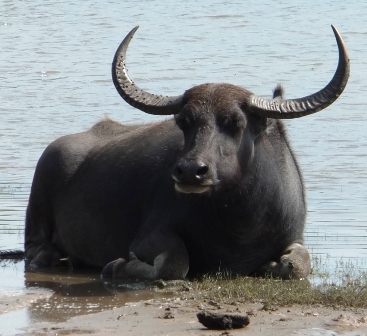Sri Lanka 2013
Episode 3: Leopard Hunt in Yala NP

Click the photo above to see an album of photos. Close the window to return to this page
Read Previous
Episode 2: Whales in
Mirissa or Next
Episode
4: Kataragama
|
January 13-14 2013 Yala NP If you want to catch a glimpse of one of the 25 leopards in Yala National Park you have to be patient, drive slowly around the park all day peering at every tree with a limb not too far from the ground, and even then you may not be lucky. We finally got lucky a half hour before the park closed for the day. The knock on the door came at 4:30 AM. Ray and I had travelled by bus from Mirissa to Tissa (Tissamaharama) the day before and now we were joining Sanne and Pieter, from the Netherlands, on an all day safari to Yala. If we wanted to be at the park for the opening at 6 AM, we had to leave our hotel at 5 AM. It was a cool and bumpy ride in our open sided jeep over pitted and rutted dirt roads, made worse by heavy rains the previous week. We were glad the skies were clear for our visit. While we waited for our driver to arrange our day passes, a wild pig with a long snout ambled over beside the jeeps looking for handouts. I think it was a semi-pet of the snack stand just outside the park entrance. Finally we were on our way through the main gates. We saw a fair number of birds in the morning, especially peacocks, egrets, painted storks, herons, eagles, colourful green and blue bee-eaters,Sri Lankan Jungle fowl, the National Bird, horn bills and other water birds. A few of the peacocks were putting on a show, strutting with their tails fanned out, trying to attract the attention of the peahens. There were small herds of spotted deer, lots of water buffalo, grey langur monkeys, crocodiles, monitor lizards, but no leopard. Yala NP covers over 1200 sq km stretching down to the
southeast coast on the Indian Ocean.
The beach was our breakfast and
lunch rest stop.
The 2004 tsunami destroyed
two large resorts full of workers and tourists on the beach
within the park that have yet to be rebuilt. All that remains
are the foundations of two small bungalows. Four stainless steel panels,
curved to depict the height of the tsunami waves and a granite
marker stand as a memorial in front of the bungalow ruins. There
was no warning for the tsunami and not even any way to spread
the word to other vulnerable areas. The government now claims to
have a good warning system in place that Sri Lankans hope never
has to be tested. |
Read Previous Episode 2: Whales in Mirissa or Next Episode 4: Kataragama
Read India 2013
Return to Sri Lanka Intro
Return to Travels
or Introduction
